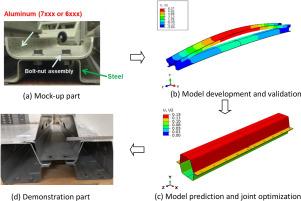在模拟油漆烘烤条件下减轻铝/钢部件的变形:实验和数值模型研究
IF 6.1
1区 工程技术
Q1 ENGINEERING, MANUFACTURING
引用次数: 0
摘要
多材料连接轻质结构对于减轻汽车重量以节约能源和减少温室气体排放至关重要。然而,在涂料烘烤过程中,不同材料的热膨胀系数不匹配会导致部件变形和粘合剂粘接的接头失效。本研究以接触力学和大变形理论为基础,建立了高强度铝合金和钢异种材料的热力学模型,以研究变形机理和残余间隙的影响因素。所建立的模型用于优化焊接条件,如间距和零件几何形状。当焊接间距小于 100 毫米时,铝和钢部件之间的最大间隙可大大减小到 0.1 毫米,与长间距情况(900 毫米)相比,在烘箱加热和冷却循环期间接头周围的局部应力和塑性应变也大大减小。数值建模结果表明,在涂料烘烤条件下,钢和铝横截面之间相当的弯曲刚度比对于间隙和变形最小化至关重要。采用数字图像相关技术测量了整体部件的变形和局部应变分布,用于验证模型预测。在油漆烘烤和冷却后,成功采用了焊接粘接(粘接与摩擦咬合)工艺将铝与钢部件连接在一起,粘接剂中没有出现间隙。本文章由计算机程序翻译,如有差异,请以英文原文为准。

Mitigation of distortion of Al/steel part under simulated paint baking condition: Experiment and numerical model studies
Multi-material joining of lightweight structures is essential to reduce vehicle weight for more energy savings and less greenhouse gas emission. However, mismatch of thermal expansion coefficient for dissimilar materials during the paint baking process can induce part distortion and joint failure for adhesive bonding. In the present work, a thermomechanical model based on contact mechanics and large deformation theory was developed for dissimilar high-strength Al alloy and steel components to study the distortion mechanism and influential factors of the residual gap. The established model was used to optimize joint conditions, such as pitch distance and part geometry. When a weld pitch is shorter than 100 mm, the maximum gap between Al and steel part can be greatly reduced to 0.1 mm, and the local stress and plastic strain around the joint during the oven heating and cooling cycle are also substantially reduced compared with the long pitch case (900 mm). The numerical modeling results revealed that a comparable bending stiffness ratio between the steel and Al cross sections is critical to the minimization of gap and distortion under paint baking condition. Digital image correlation technique was used to measure the overall part distortion and local strain distribution that were used to validate the model prediction. Weld bonding (adhesive bonding with friction bit joining) process was successfully employed to join Al to steel component without gap opening in adhesive after the paint baking and cooling.
求助全文
通过发布文献求助,成功后即可免费获取论文全文。
去求助
来源期刊

Journal of Manufacturing Processes
ENGINEERING, MANUFACTURING-
CiteScore
10.20
自引率
11.30%
发文量
833
审稿时长
50 days
期刊介绍:
The aim of the Journal of Manufacturing Processes (JMP) is to exchange current and future directions of manufacturing processes research, development and implementation, and to publish archival scholarly literature with a view to advancing state-of-the-art manufacturing processes and encouraging innovation for developing new and efficient processes. The journal will also publish from other research communities for rapid communication of innovative new concepts. Special-topic issues on emerging technologies and invited papers will also be published.
 求助内容:
求助内容: 应助结果提醒方式:
应助结果提醒方式:


